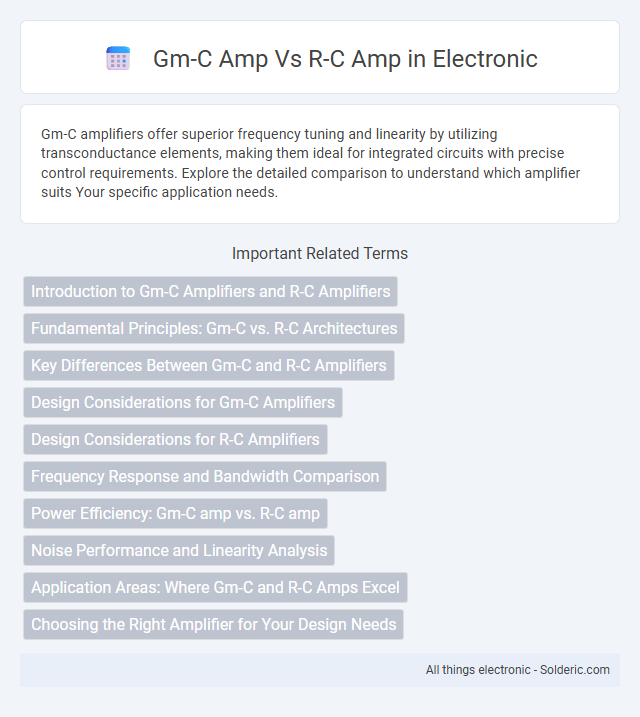Gm-C amplifiers offer superior frequency tuning and linearity by utilizing transconductance elements, making them ideal for integrated circuits with precise control requirements. Explore the detailed comparison to understand which amplifier suits Your specific application needs.
Comparison Table
| Feature | Gm-C Amplifier | R-C Amplifier |
|---|---|---|
| Frequency Response | Wide, tunable by adjusting transconductance (Gm) | Limited by resistor and capacitor values |
| Noise Performance | Lower noise, ideal for integrated circuits | Higher noise due to resistor thermal noise |
| Power Consumption | Typically lower, depends on bias current | Generally higher due to resistor power dissipation |
| Integration Suitability | High, easy on-chip integration | Moderate, bulky resistors limit integration |
| Tuning Capability | Voltage/current controlled; dynamic tuning possible | Fixed by component values; manual adjustment only |
| Linearity | Good, but dependent on transistor linearity | Typically better linearity due to passive elements |
| Applications | High-frequency filters, continuous-time filters, PLLs | Low-frequency amplification, audio circuits |
Introduction to Gm-C Amplifiers and R-C Amplifiers
Gm-C amplifiers use transconductance amplifiers coupled with capacitors to achieve high-frequency performance and tunable gain, making them ideal for integrated circuits in communication systems. R-C amplifiers rely on resistors and capacitors for signal filtering and amplification, offering simpler design but limited bandwidth compared to Gm-C types. Understanding your application's frequency and integration requirements helps determine the optimal choice between these amplifier types.
Fundamental Principles: Gm-C vs. R-C Architectures
Gm-C amplifiers use transconductance elements to convert input voltage into output current, providing high linearity and tunable gain through bias control, making them ideal for integrated circuits and high-frequency applications. R-C amplifiers rely on resistor-capacitor networks to shape frequency response and set amplifier bandwidth, often resulting in simpler design but larger silicon area and less tuning flexibility. Your choice between Gm-C and R-C architectures depends on trade-offs in linearity, tunability, and integration constraints for your analog signal processing needs.
Key Differences Between Gm-C and R-C Amplifiers
Gm-C amplifiers use a transconductance element and capacitor to achieve frequency control, providing higher gain-bandwidth product and superior linearity compared to traditional R-C amplifiers, which rely on resistor-capacitor networks for setting frequency response. The Gm-C design excels in low-voltage, high-frequency applications due to its tunability and reduced sensitivity to process variations, while R-C amplifiers offer simplicity and easier implementation at the cost of limited frequency range and larger chip area. Your choice between Gm-C and R-C amplifiers hinges on the required bandwidth, power consumption, and integration complexity in your specific analog circuit design.
Design Considerations for Gm-C Amplifiers
Gm-C amplifiers rely on transconductance elements and capacitors, providing high-frequency performance and tunability through bias currents, making them ideal for integrated circuits in analog signal processing. Design considerations include choosing the appropriate transistor operating region, ensuring linearity, and managing noise and distortion by optimizing the transconductance value and capacitor sizes. Understanding these parameters allows you to achieve precise frequency response and stability not easily attainable with traditional R-C amplifiers.
Design Considerations for R-C Amplifiers
R-C amplifiers require careful design considerations to maintain frequency stability and minimize phase shift, relying on resistor-capacitor networks for signal amplification. The selection of resistor and capacitor values directly influences bandwidth, gain, and noise performance, demanding precise calculations tailored to your application. Proper layout techniques and component quality are essential to ensure reliable operation and consistent amplification characteristics in R-C amplifier designs.
Frequency Response and Bandwidth Comparison
Gm-C amplifiers exhibit superior high-frequency response and wider bandwidth due to the transconductance-controlled capacitor providing a constant gm, enabling faster signal transitions compared to the resistor-capacitor (R-C) amplifiers where resistor-induced time constants limit bandwidth. The frequency response of Gm-C amps can be precisely tuned by adjusting the transconductance, allowing enhanced performance in high-speed analog circuits, whereas R-C amps face bandwidth constraints stemming from fixed resistor values and parasitic effects. Consequently, Gm-C amplifiers are often preferred in applications requiring wide bandwidth and improved linearity at high frequencies.
Power Efficiency: Gm-C amp vs. R-C amp
Gm-C amplifiers offer superior power efficiency compared to R-C amplifiers by using transconductance elements that consume less static power while maintaining high bandwidth. R-C amplifiers rely on resistors that generate constant power dissipation due to static current flow, leading to higher overall power consumption. You can achieve lower power consumption and enhanced performance in integrated circuits with Gm-C amplifiers, especially in low-voltage and power-sensitive applications.
Noise Performance and Linearity Analysis
Gm-C amplifiers exhibit superior noise performance due to their continuous-time operation and reduced thermal noise contribution compared to R-C amplifiers, which often suffer increased noise from resistor thermal fluctuations. The linearity of Gm-C amps is generally enhanced by the transconductance stage's ability to maintain a more constant gain over a wide frequency range, whereas R-C amps can introduce nonlinear distortion through resistor-induced voltage drops. Consequently, Gm-C amplifiers are preferred in high-frequency, low-noise applications where precise linear response is critical.
Application Areas: Where Gm-C and R-C Amps Excel
Gm-C amplifiers excel in high-frequency and integrated circuit applications due to their tunability and low area consumption, making them ideal for RF and mixed-signal designs. R-C amplifiers are preferred in low-frequency, high-precision analog circuits where linearity and stability are critical, such as audio processing and instrumentation. Your choice depends on the required frequency range and integration level of the application.
Choosing the Right Amplifier for Your Design Needs
Gm-C amplifiers offer superior high-frequency performance and tunability, making them ideal for precision analog filters and integrated circuits requiring low distortion and low noise. R-C amplifiers provide simplicity and ease of implementation, suitable for general-purpose amplification where power consumption and linearity are less critical. Your choice depends on whether your design prioritizes frequency accuracy and integration density (favoring Gm-C) or cost-effectiveness and straightforward design (favoring R-C).
Gm-C amp vs R-C amp Infographic

 solderic.com
solderic.com